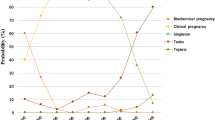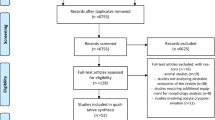Similar content being viewed by others
References
Delvigne A and Rozenberg S (2002) Epidemiology and prevention of ovarian hyperstimulation syndrome (OHSS): a review. Hum Reprod Update 8: 559–577
De Leener A et al. (2006) Presence and absence of FSH receptor mutations provide some insights to spontaneous ovarian hyperstimulation physiopathology. J Clin Endocrinol Metab 91: 555–562
Vasseur C et al. (2003) A chorionic gonadotropin-sensitive mutation in the follicle-stimulating hormone receptor as a cause of familial gestational spontaneous ovarian hyperstimulation syndrome. N Engl J Med 349: 753–759
Smits G et al. (2003) Ovarian hyperstimulation syndrome due to a mutation in the follicle-stimulating hormone receptor. N Engl J Med 349: 760–766
Delbaere A et al. (2004) New insights into the pathophysiology of ovarian hyperstimulation syndrome. What makes the difference between spontaneous and iatrogenic syndrome? Hum Reprod 19: 486–489
Simoni M et al. (2002) Isoforms and single nucleotide polymorphisms of the FSH receptor gene: implications for human reproduction. Hum Reprod Update 8: 413–421
Greb RR et al. (2005) A common single nucleotide polymorphism in exon 10 of the human follicle stimulating hormone receptor is a major determinant of length and hormonal dynamics of the menstrual cycle. J Clin Endocrinol Metab 90: 4866–4872
Behre HM et al. (2005) Significance of a common single nucleotide polymorphism in exon 10 of the follicle-stimulating hormone (FSH) receptor gene for the ovarian response to FSH: a pharmacogenetic approach to controlled ovarian hyperstimulation. Pharmacogenet Genomics 15: 451–456
Daelemans C et al. (2004) Prediction of severity of symptoms in iatrogenic ovarian hyperstimulation syndrome by follicle-stimulating hormone receptor Ser680Asn polymorphism. J Clin Endocrinol Metab 89: 6310–6315
De Castro F et al. (2005) Pharmacogenetics of controlled ovarian hyperstimulation. Pharmacogenomics 6: 629–637
Acknowledgements
Supported by the Interuniversity Attraction Poles of the Belgian Federal Office for Scientific, Technical and Cultural Affairs, and grants from the Fonds pour la Recherche Scientifique Médicale, the Fonds National de la Recherche Scientifique and Fondation Erasme.
Author information
Authors and Affiliations
Corresponding author
Ethics declarations
Competing interests
The authors declare no competing financial interests.
Rights and permissions
About this article
Cite this article
Delbaere, A., Smits, G., Vassart, G. et al. Genetic predictors of ovarian hyperstimulation syndrome in women undergoing in vitro fertilization. Nat Rev Endocrinol 2, 590–591 (2006). https://doi.org/10.1038/ncpendmet0319
Received:
Accepted:
Issue Date:
DOI: https://doi.org/10.1038/ncpendmet0319
- Springer Nature Limited
This article is cited by
-
What is the best predictor of severe ovarian hyperstimulation syndrome in IVF? A cohort study
Journal of Assisted Reproduction and Genetics (2017)
-
Ovarielles Überstimulationssyndrom
Gynäkologische Endokrinologie (2007)





